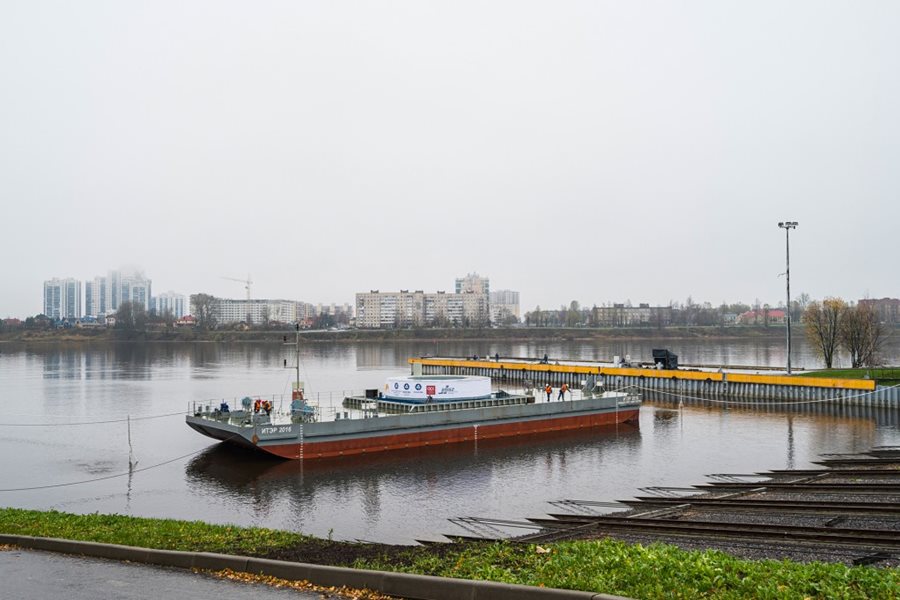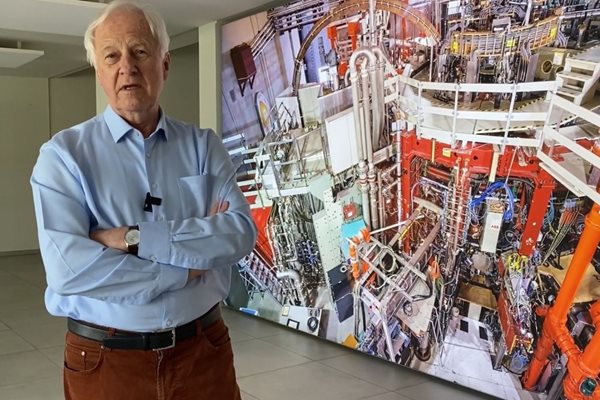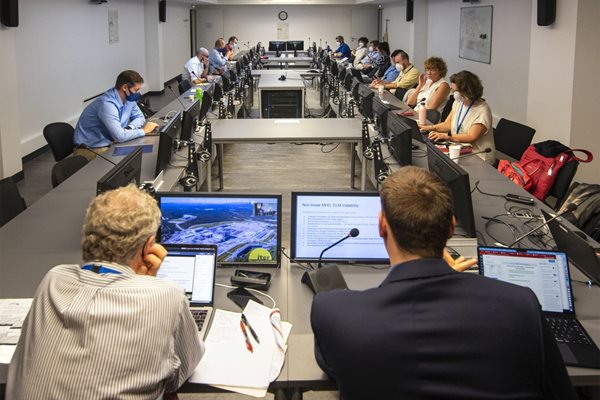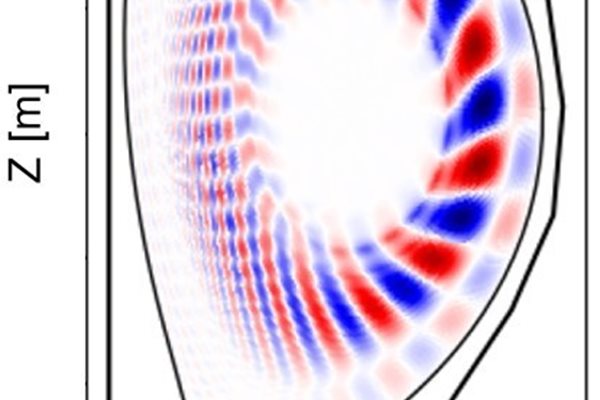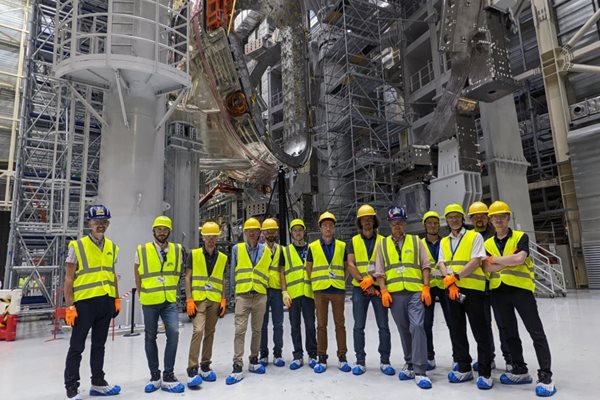
you're currently reading the news digest published from 31 Oct 2022 to 07 Nov 2022
featured6
of-interest1
press28
featured
Russia | The top ring is on its way
After a ceremonial launch at the Sredne Nevsky shipyard in Saint Petersburg, ITER's smallest ring-shaped magnet—poloidal field coil #1 (PF1)—has been loaded on a transport vessel for shipment to ITER. On 1 November, a small crowd had gathered to witness the historic departure of the component from the factory, including representatives from the Russian State Duma, Rosatom, the ITER Organization, and city officials. "This event is of enormous importance both for domestic enterprises that participated in the manufacture of this most complex component of the future thermonuclear reactor, and for the entire project as a whole," said Anatoly Krasilnikov, director of the Russian Domestic Agency for ITER. "This is an outstanding result of many years of fruitful, well-coordinated work of leading Russian institutes and industrial enterprises, a spectacular demonstration of our scientific and technological potential." Six ring-shaped poloidal field coils will be positioned horizontally outside of the ITER vacuum vessel and toroidal field magnet system to shape the plasma and contribute to its stability by "pinching" it away from the walls. With a combined weight of approximately 1,800 tonnes and diameters ranging from 9 metres to 24 metres, the poloidal field coil system is one of the three major magnetic systems of the ITER device. The coils are built from layers of niobium-titanium superconductor wound into double layers called pancakes. The work to build eight double pancakes for PF1 was carried out in Russia between 2016 and 2019. The coil impregnation phase followed, and in March 2022, the magnet passed all factory acceptance tests. The most important technologies and equipment for the manufacture of the coil were developed at JSC NIIEFA (Rosatom State Corporation), while manufacturing was carried out at the Sredne Nevsky Shipyard (JSC SNSZ) in Saint Petersburg. PF1 is one of the 25 systems included in the sphere of responsibility of the Russian Federation within the framework of the ITER Project.
Fusion history | H-mode, the discovery that made ITER possible
Forty years ago, the scientists in the ASDEX tokamak control room at the Max Planck Institute for Plasma Physics (IPP) in Germany sat up straight. Something new had happened during what was expected to be a routine day of experiments ... a never-before-seen state of the plasma, which would later come to be called H-mode, for "high confinement." When shared with the world plasma community, some thought at first that it must be a measurement error ... Thursdays were experimental days on ASDEX. On this particular Thursday, in February 1982, there was nothing to indicate that history would be made. A series of neutral-beam-heated discharges was planned, and scientists expected to confirm what they had seen before—that these plasmas had the advantage of being extremely reproduceable, but the disadvantage of quickly degrading confinement. But suddenly, there was a dramatic change across all plasma parameters. As the plasma in ASDEX was exposed to intense heating by the neutral beam, its confinement suddenly improved by a factor of two and the turbulence at the plasma edge all but disappeared. "All the scientists in the ASDEX control room realized that something extraordinary had happened," recalls Friedrich Wagner, who was responsible for this area of research at ASDEX at the time. This unexpected transition from L-mode ("low-confinement," where confinement could not be sustained) to improved H-mode—a development that was soon reproduceable in tokamaks around the world—changed the game, influencing tokamak design and opening the door to a project like ITER. "The discovery of the H-mode is what made ITER possible in the first place," says Elisabeth Wolfrum in an article published by IPP to mark the anniversary of the discovery of H-mode. "Through H-mode research, we are getting closer and closer to plasma operating states that are most suitable for large fusion facilities like ITER." The now-emeritus H-mode discoverer Friedrich Wagner is excited about the completely new possibilities that the fusion facility in southern France will offer once it is completed. "ITER will be an instrument like we've never had on Earth before." From his work on ASDEX—and especially from the H-mode year 1982—he has learned one thing: "Progress does not always develop linearly. In between, there are completely unexpected big leaps forward. That's what makes science so exciting." Read the full article on the IPP website in English or in German. See Friedrich Wagner tell the story of the discovery of H-mode in this 22-minute video.
International Tokamak Physics Activity | ITPA meetings resume at ITER
After a hiatus of three years due to Covid, in-person meetings of experts from the International Tokamak Physics Activity (ITPA), supporting research for ITER, have resumed. On-site meetings at the ITER Organization or the nearby CEA research centre allow ITPA experts to witness progress in construction since their last visit to the ITER Organization in 2019. The International Tokamak Physics Activity (ITPA), under the auspices of the ITER Organization, coordinates research among the ITER Members to develop the physics and operational basis of burning tokamak plasmas with specific focus on ITER. This includes the Physics Basis behind ITER's design as well as the optimization of its scientific exploitation (ITER Research Plan). The ITPA research activities involve the execution of joint experiments and validation of models to improve the predictions for burning plasmas, in particular of ITER high-Q scenarios. The implementation of these activities frequently involves short-term exchanges of researchers among the participating institutions (under the IEA Technology Collaboration Programme on Tokamak Programmes). Research progress is reported at the bi-annual meetings of the corresponding ITPA Topical Group leading the activity. Since March 2020, with the start of the Covid pandemic, travel restrictions have forced ITPA meetings and activities, such as joint experiments, to take place almost exclusively via remote participation. Remote participation and teleconference tools have been extensively used by the ITPA to maintain progress of research over the last years. However, these tools cannot fully substitute the scientific exchanges among experts during in-person participation in experiments and face-to-face discussions at meetings, which greatly contribute to the acceleration of research and the drawing of conclusions for ITER. The easing of the Covid pandemic and of travel restrictions have allowed the organization of in-person meetings of the ITPA Topical Groups, which started in earnest this autumn after a three-year hiatus. The Diagnostics, Transport and Confinement, Pedestal and Edge Physics, Scrape-Off Layer and Divertor Topical Group experts met at the ITER Organization and CEA in October (up to three of them meeting simultaneously), while Integrated Operations Scenarios and Energetic Particle Physics Topical Group experts will meet in November also at ITER. Besides the more productive scientific discussions allowed by the in-person participation at these meetings, the ITPA experts are given the opportunity to witness the major progress in tokamak construction since their last visit to the ITER Organization in 2019. The in-person meetings of the ITPA in 2022 will conclude with that of the Coordinating Committee in December during which progress on research in 2022 by the Topical Groups will be reviewed and the plans for 2023 will be discussed.
Education | 12th ITER International School announced
The 12th ITER International School (IIS) will be held from 26 to 30 June 2023, hosted by Aix-Marseille University in Aix-en-Provence, France. The subject of the 2023 school is "The Impact and Consequences of Energetic Particles on Fusion Plasmas," with a scientific program coordinated by Simon Pinches (ITER Organization). As the start of ITER operations approaches, it is timely to address this multidisciplinary topic that includes plasma self-heating by fusion-born alpha-particles, the influence of energetic particles on stability, diagnosing energetic particle transport and loss, and understanding runaway electrons. The ITER International School aims to prepare young scientists and engineers for working in the field of nuclear fusion and in research applications associated with the ITER Project. The adoption of a "school" format was a consequence of the need to prepare future scientists and engineers on a range of different subjects and to provide them with a wide overview of the interdisciplinary skills required by ITER. The first ITER School was organized in Aix-en-Provence, France, in July 2007 and focused on turbulent transport in fusion plasmas. Ten successive schools have followed on a variety of subjects: magnetic confinement (Fukuoka, Japan, 2008); plasma-surface interactions (Aix-en-Provence, 2009); magneto-hydro-dynamics and plasma control (Austin, Texas, USA, 2010); energetic particles (Aix-en-Provence, 2011); radio-frequency heating (Ahmedabad, India, 2012); high-performance computing in fusion science (Aix-en-Provence, 2014); transport and pedestal physics in tokamaks (Hefei, China, 2016); physics of disruptions and control (Aix-en-Provence, 2017); the physics and technology of power flux handling (Daejeon, Korea, 2019); and ITER plasma scenarios and control (San Diego, USA, 2022). Further information on the 2023 school will be available before the end of November at https://iis2023.sciencesconf.org/. Find out more about past schools here.
Image of the week | 4 frames out of 13
Judging by the first elements of its steel structure, the Neutral Beam High Voltage Building, located adjacent to the Tokamak Complex, will be a spectacular addition to the ITER platform. Neutral beams are fluxes of high-energy particles that have two functions in ITER: one is to deliver heating power to the plasma and the other is to probe it for diagnostic purposes. Whether for heating or for diagnostic measurement, the massive neutral bean injectors require specific power supply systems. The Neutral Beam High Voltage Building (B37) will comprise three halls; the smallest, whose steel structure is being erected, will host the power supply systems for the diagnostic neutral beam, while the two largest will each be home to the massive high-voltage decks, their giant bushings, and the transmission lines that will deliver 1 MV of ultra-high voltage to the heating neutral beam injectors. In a little more than one week, four out of the required 13 steel frames (15 to 25 metres tall) have been bolted to the concrete slab. Running alongside the Tokamak Complex, the building will extend 84 metres in length and 28 metres in width. Once clad in ITER's signature mirror-like stainless steel and dark grey-lacquered metal, B37 will look like any large building on the platform. The equipment and systems it will accommodate have no equivalent in the world.
ITER cybersecurity symposium | Stronger together
Cybersecurity is tough work. Every day new vulnerabilities are found, new malware is created, and new companies and organizations are hit with ransomware attacks and data breaches. Protecting an organization like ITER against these cyber threats means constantly adapting security measures to new threats, raising awareness, and preventing cyber incidents while still allowing our organization to have the best IT service to continue working. All organizations in the world are facing the same challenges, and trading notes on best practices is one way to keep abreast of the latest developments. As part of its efforts to keep ITER safe from cyberattack, the Information Technology (IT) Division held its first ITER cybersecurity symposium this past summer. This event gathered 14 IT security experts from various industries and organizations, all sharing a common goal: how to better defend our organizations from ever-growing and ever-changing cyber threats. 'In cybersecurity, more than ever, peer-driven collaboration and knowledge sharing are critical,' says Romain Bourgue, cybersecurity officer for ITER and organizer of the event. 'We are facing the same challenges and fighting the same enemy. Collectively, we have accumulated enormous experience through the attacks and incidents we have faced, our security awareness campaigns, and our cybersecurity improvement projects. Sharing among peers, without commercial actors, what has really worked in our organizations—and even more importantly what has failed and why—helps everyone improve their cybersecurity posture.' During the one-day event, participants in the ITER cybersecurity symposium shared lessons learned and best practices on various hot topics in cybersecurity. Jerome Poggi, chief information security officer (CISO) for the city of Marseille, described the ransomware attack they faced in 2020. Kevin Heydon from the French governmental agency for cybersecurity, ANSSI, presented the best practices they have gathered for handling cybersecurity crises. Jerome Depierre, CISO for the French agricultural cooperative Limagrain, detailed the top-down strategy deployed to raise cybersecurity awareness throughout the group's 9,000 employees. Other topics ranged from secure development practices to the place occupied by women in cybersecurity. The day concluded with a site visit and the strong determination of all participants to meet again to keep the exchange of experience going.
of-interest
ITER wins "Construction Story of the Year" award
The B1M, a popular video channel for construction, architecture and engineering, and the Nemetschek Group, a leading software providers for the same industries, named ITER as the Construction Story of the Year award on 2 November 2022 in Munich. The expert judging panel was "particularly impressed by the extraordinary levels of collaboration between the construction team, and the scheme's propensity to inspire future generations of engineers." "ITER is a remarkable project that impressively demonstrates what the construction industry is able to achieve. The team has come together collaborating across international borders working on a massive project scale inspiring this and future generations of engineers and all roles contributing to our built world. The project team has proven that working together knows no bounds—regardless of segment, trade or project size, amazing goals can be realized," said Don Jacob, VP Technology and Innovation, Build & Construct Division at the Nemetschek Group. The Construction Story of the Year program aims to highlight the world's most impressive and inspiring construction stories, seeking out amazing projects, ideas or initiatives that show the best of the architecture, engineering, and construction (AEC) industry. It aims particularly to highlight innovation in the construction industry and projects that represent its digital transformation. Read press releases from The B1M and the Nemetschek Group. See the video published about ITER by The B1M channel in April 2022. --Jens Reich, Head of ITER's Vessel Delivery and Assembly Division (centre) at the ceremony in Munich on 2 November 2022, alongside The B1M founder Fred Mills (left) and Nemetschek's VP of Technology and Innovation, Build and Construct Division, Don Jacob (right).
